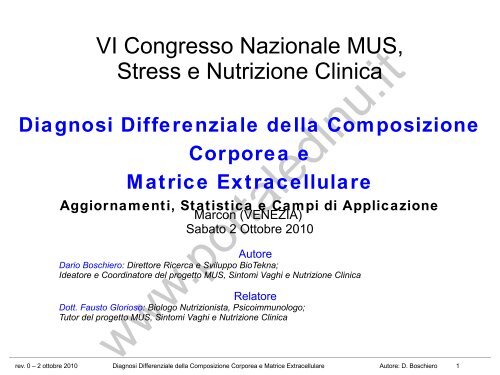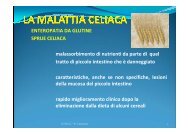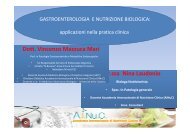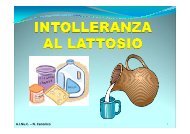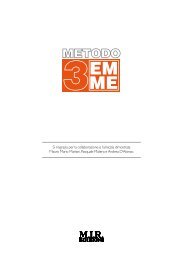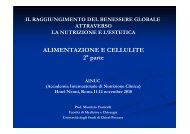Diagnosi Differenziale della Composizione Corporea e Matrice ...
Diagnosi Differenziale della Composizione Corporea e Matrice ...
Diagnosi Differenziale della Composizione Corporea e Matrice ...
Create successful ePaper yourself
Turn your PDF publications into a flip-book with our unique Google optimized e-Paper software.
VI Congresso Nazionale MUS,<br />
Stress e Nutrizione Clinica<br />
<strong>Diagnosi</strong> <strong>Differenziale</strong> <strong>della</strong> <strong>Composizione</strong><br />
<strong>Corporea</strong> e<br />
<strong>Matrice</strong> Extracellulare<br />
Aggiornamenti, Statistica e Campi di Applicazione<br />
Marcon (VENEZIA)<br />
Sabato 2 Ottobre 2010<br />
Autore<br />
Dario Boschiero: Direttore Ricerca e Sviluppo BioTekna;<br />
Ideatore e Coordinatore del progetto MUS, Sintomi Vaghi e Nutrizione Clinica<br />
Relatore<br />
Dott. Fausto Glorioso: Biologo Nutrizionista, Psicoimmunologo;<br />
Tutor del progetto MUS, Sintomi Vaghi e Nutrizione Clinica<br />
www.portaledinu.it<br />
rev. 0 – 2 ottobre 2010 <strong>Diagnosi</strong> <strong>Differenziale</strong> <strong>della</strong> <strong>Composizione</strong> <strong>Corporea</strong> e <strong>Matrice</strong> Extracellulare Autore: D. Boschiero 1
<strong>Composizione</strong> <strong>Corporea</strong> e <strong>Matrice</strong> Extracellulare<br />
- Background<br />
FFM:<br />
min 50% acqua (ICW 60% + ECW 40%)<br />
21% proteine<br />
1% glicogeno<br />
6% minerali<br />
2% acidi grassi essenziali<br />
BM<br />
FFM min 75% FM max 25%<br />
FFM= TBW+ossa+minerale non osseo+proteine<br />
TBW min 50% ECM 15%-20%<br />
ICW 60% ECW 40%<br />
PA min 3.5°<br />
ECM<br />
<strong>Matrice</strong><br />
extracellulare<br />
Processi infiammatori cronici<br />
Stress cronico asse HPA e SNA (SNS/SNP)<br />
Sintomi vaghi ed aspecifici - MUS<br />
www.portaledinu.it<br />
rev. 0 – 2 ottobre 2010 <strong>Diagnosi</strong> <strong>Differenziale</strong> <strong>della</strong> <strong>Composizione</strong> <strong>Corporea</strong> e <strong>Matrice</strong> Extracellulare Autore: D. Boschiero 2<br />
FM<br />
FM
Analisi quantitativa<br />
Peso Attuale<br />
Peso Ideale ↑<br />
BD<br />
(Body Density) ↓<br />
AGEs ?<br />
<strong>Composizione</strong> <strong>Corporea</strong> e <strong>Matrice</strong> Extracellulare<br />
- Background<br />
Nutrizione Idratazione<br />
perdita massa magra<br />
FFM ↓<br />
FM ↑<br />
ECM↑<br />
TBW ↓<br />
BMR ↓<br />
MUS<br />
perdita acqua<br />
intracellulare<br />
ICW ↓<br />
ECW ↑<br />
Processi<br />
infiammatori<br />
cronici<br />
www.portaledinu.it<br />
Analisi qualitativa<br />
rev. 0 – 2 ottobre 2010 <strong>Diagnosi</strong> <strong>Differenziale</strong> <strong>della</strong> <strong>Composizione</strong> <strong>Corporea</strong> e <strong>Matrice</strong> Extracellulare Autore: D. Boschiero 3<br />
PA ↓<br />
Squilibri<br />
ormonali
<strong>Composizione</strong> <strong>Corporea</strong> e <strong>Matrice</strong> Extracellulare<br />
- Background<br />
ECM: matrice extracellulare<br />
• composta da una complessa e dinamica rete di macromolecole<br />
extracellulari, secrete<br />
loca<br />
l<br />
mente, che si aggregano in un reticolo organizzato in maniera<br />
compatta e connessa alla superficie<br />
d<br />
ella cellula che l’ha prodotta.<br />
• ha un ruolo attivo e complesso nel comportamento<br />
d<br />
elle cellule con cui è a contatto.<br />
•<br />
d<br />
ha forma e composizione diversa a seconda<br />
ei<br />
d<br />
vari tessuti e<br />
www.portaledinu.it<br />
rev. 0 – 2 ottobre 2010 <strong>Diagnosi</strong> <strong>Differenziale</strong> <strong>della</strong> <strong>Composizione</strong> <strong>Corporea</strong> e <strong>Matrice</strong> Extracellulare Autore: D. Boschiero 4
<strong>Composizione</strong> <strong>Corporea</strong> e <strong>Matrice</strong> Extracellulare<br />
- Background<br />
ECM: matrice extracellulare<br />
Le macromolecole che la compongono possono essere suddivise in:<br />
Collageni – Proteoglicani – Glicoproteine<br />
Il collagene rappresenta il maggior componente <strong>della</strong> ECM, costituisce il 25-30%<br />
delle proteine, conferisce integrità, stabilità e proprietà meccaniche organo<br />
specifiche.<br />
I proteoglicani hanno come funzioni principali la movimentazione e trasporto<br />
capillare delle molecole di acqua ed elettroliti all'interno delle parti solidegelatinose,<br />
l'interazione con il collagene e interazione tra le cellule.<br />
Le glicoproteine hanno varie funzioni tra cui quella di stimolare la crescita<br />
cellulare, funzione di sostegno e aggregazione.<br />
www.portaledinu.it<br />
rev. 0 – 2 ottobre 2010 <strong>Diagnosi</strong> <strong>Differenziale</strong> <strong>della</strong> <strong>Composizione</strong> <strong>Corporea</strong> e <strong>Matrice</strong> Extracellulare Autore: D. Boschiero 5
<strong>Composizione</strong> <strong>Corporea</strong> e <strong>Matrice</strong> Extracellulare<br />
- Background<br />
Rimo<strong>della</strong>mento <strong>della</strong> matrice extracellulare ECM<br />
La matrice extracellulare è soggetta ad un continuo rimo<strong>della</strong>mento<br />
in quanto gioca un ruolo importantissimo nella diffusione di tutti<br />
i segnali biochimici che modulano la proliferazione cellulare,<br />
differenziazione, sopravvivenza e migrazione.<br />
Il rimo<strong>della</strong>mento <strong>della</strong> ECM avviene sia in condizioni fisiologiche<br />
che in condizioni patologiche.<br />
www.portaledinu.it<br />
rev. 0 – 2 ottobre 2010 <strong>Diagnosi</strong> <strong>Differenziale</strong> <strong>della</strong> <strong>Composizione</strong> <strong>Corporea</strong> e <strong>Matrice</strong> Extracellulare Autore: D. Boschiero 6
<strong>Composizione</strong> <strong>Corporea</strong> e <strong>Matrice</strong> Extracellulare<br />
- Background<br />
ECM: matrice extracellulare<br />
Il rimo<strong>della</strong>mento <strong>della</strong> ECM in condizioni fisiologiche segue una<br />
ritmicità circadiana bifasica.<br />
Nella prima fase <strong>della</strong> giornata dalle 3 alle 15 circa appare come una<br />
gelatina solubilizzata (ECM in stato di SOL) ed in questa prima parte<br />
<strong>della</strong> giornata avviene la demolizione e lo smaltimento di scorie e proteine<br />
(fase di smaltimento).<br />
Nella seconda fase <strong>della</strong> giornata dalle 15 alle 3 circa l'ECM appare,<br />
invece, come una gelatina che si ricondensa (ECM in stato di GEL) ed in<br />
questa seconda parte <strong>della</strong> giornata avviene la<br />
ricostituzione <strong>della</strong> matrice e delle proteine<br />
(fase di ricostruzione).<br />
www.portaledinu.it<br />
rev. 0 – 2 ottobre 2010 <strong>Diagnosi</strong> <strong>Differenziale</strong> <strong>della</strong> <strong>Composizione</strong> <strong>Corporea</strong> e <strong>Matrice</strong> Extracellulare Autore: D. Boschiero 7
<strong>Composizione</strong> <strong>Corporea</strong> e <strong>Matrice</strong> Extracellulare<br />
- Background<br />
ECM: rimo<strong>della</strong>mento<br />
STATO di SOL (fase di smaltimento 3--15):<br />
Simpaticotonia<br />
Idrolisi proteica<br />
Degradazione<br />
Smaltimento<br />
STATO di GEL (fase di ricostruzione 15--3):<br />
Vagotonia<br />
Ricostruzione proteica<br />
Ad ogni demolizione segue una ricostruzione e viceversa.<br />
www.portaledinu.it<br />
rev. 0 – 2 ottobre 2010 <strong>Diagnosi</strong> <strong>Differenziale</strong> <strong>della</strong> <strong>Composizione</strong> <strong>Corporea</strong> e <strong>Matrice</strong> Extracellulare Autore: D. Boschiero 8
traumi<br />
<strong>Composizione</strong> <strong>Corporea</strong> e <strong>Matrice</strong> Extracellulare<br />
- Background<br />
ECM: matrice extracellulare<br />
Questo equilibrio circadiano bifasico può rompersi.<br />
come?<br />
infezioni virali o batteriche<br />
insufficienza funzionale del sistema linfatico<br />
eccessiva produzione di tossine<br />
dovuta ad errata alimentazione<br />
assunzione di sostanze farmacologiche<br />
condizione di stress<br />
In queste condizioni l'organismo va ad attivare uno<br />
stato suppletivo per accelerare lo smaltimento:<br />
l'infiammazione.<br />
www.portaledinu.it<br />
rev. 0 – 2 ottobre 2010 <strong>Diagnosi</strong> <strong>Differenziale</strong> <strong>della</strong> <strong>Composizione</strong> <strong>Corporea</strong> e <strong>Matrice</strong> Extracellulare Autore: D. Boschiero 9
<strong>Composizione</strong> <strong>Corporea</strong> e <strong>Matrice</strong> Extracellulare<br />
- Background<br />
Rimo<strong>della</strong>mento <strong>della</strong> matrice extracellulare ECM<br />
e Infiammazione Cronica<br />
In presenza di un processo infiammatorio vengono messi in atto<br />
una serie di meccanismi che inducono il rimo<strong>della</strong>mento <strong>della</strong> ECM;<br />
l’infiammazione è una risposta al danno dei tessuti i cui<br />
ruoli principali sono la rimozione dei tessuti danneggiati<br />
e la protezione contro le infezioni.<br />
Se sono contemporaneamente presenti<br />
l’agente dannoso o stressor,<br />
la lesione dei tessuti,<br />
i tentativi di guarigione del tessuto danneggiato<br />
e la risposta immunitaria,<br />
si genera uno stato infiammatorio cronico.<br />
www.portaledinu.it<br />
rev. 0 – 2 ottobre 2010 <strong>Diagnosi</strong> <strong>Differenziale</strong> <strong>della</strong> <strong>Composizione</strong> <strong>Corporea</strong> e <strong>Matrice</strong> Extracellulare Autore: D. Boschiero 10
<strong>Composizione</strong> <strong>Corporea</strong> e <strong>Matrice</strong> Extracellulare<br />
- Background<br />
ECM: matrice extracellulare<br />
infiammazione cronica<br />
Condizione in cui lo smaltimento e il rimo<strong>della</strong>mento dell'ECM non<br />
risulta piu' sufficiente rispetto allo scarto quantitativo<br />
nell'extracellulare di acidi organici relativi al catabolismo <strong>della</strong> FFM<br />
da ECM circadiana bifasica ad assenza di circadianità<br />
con conseguente perdita progressiva di integrità anatomo funzionale<br />
e relativo aumento <strong>della</strong> percentuale dell'ECM rispetto alla BM<br />
(aumento di cataboliti)<br />
Valori di ECM normo: da 15% a 20% rispetto alla BM e circadianità bifasica<br />
www.portaledinu.it<br />
rev. 0 – 2 ottobre 2010 <strong>Diagnosi</strong> <strong>Differenziale</strong> <strong>della</strong> <strong>Composizione</strong> <strong>Corporea</strong> e <strong>Matrice</strong> Extracellulare Autore: D. Boschiero 11
<strong>Composizione</strong> <strong>Corporea</strong> e <strong>Matrice</strong> Extracellulare<br />
- Background<br />
ECM e infiammazione cronica<br />
Le cause del fenomeno sono molteplici, ma a giocare un ruolo<br />
determinante è la rottura del fisiologico equilibrio tra la produzione<br />
e l'eliminazione ad opera dei sistemi di difesa antiossidanti<br />
delle specie reattive dell'ossigeno Ros<br />
I Ros attraverso meccanismi sia diretti che indiretti, favoriscono la<br />
distruzione ed impediscono la sintesi delle proteine <strong>della</strong><br />
matrice, innescando fenomeni anomali di riparazione tissutale e<br />
rimo<strong>della</strong>mento <strong>della</strong> matrice stessa<br />
(aumento <strong>della</strong> percentuale dell'ECM rispetto alla BM)<br />
www.portaledinu.it<br />
rev. 0 – 2 ottobre 2010 <strong>Diagnosi</strong> <strong>Differenziale</strong> <strong>della</strong> <strong>Composizione</strong> <strong>Corporea</strong> e <strong>Matrice</strong> Extracellulare Autore: D. Boschiero 12
<strong>Composizione</strong> <strong>Corporea</strong> e <strong>Matrice</strong> Extracellulare<br />
- Background<br />
ECM e infiammazione cronica<br />
Gli scambi metabolici si rallentano, la comunicazione intercellulare è<br />
compromessa e i residui tossici delle attività cellulari si accumulano,<br />
innescando un pericoloso circolo vizioso che accelera<br />
il catabolismo <strong>della</strong> massa magra FFM<br />
Il processo di riparazione tissutale viene notevolmente rallentato con<br />
accumulo di sostanze lesive o non più utili. Le cellule risentono<br />
immediatamente delle alterazioni <strong>della</strong> ECM riducendo la capacità di<br />
assimilare i nutrienti e di reagire all'azione dei farmaci ai normali dosaggi.<br />
la perdita graduale delle proprietà biochimiche e funzionali del ECM<br />
facilita l'insorgenza di condizioni croniche a carico di tutti gli<br />
organi.<br />
www.portaledinu.it<br />
rev. 0 – 2 ottobre 2010 <strong>Diagnosi</strong> <strong>Differenziale</strong> <strong>della</strong> <strong>Composizione</strong> <strong>Corporea</strong> e <strong>Matrice</strong> Extracellulare Autore: D. Boschiero 13
<strong>Composizione</strong> <strong>Corporea</strong> e <strong>Matrice</strong> Extracellulare<br />
- Background<br />
ECM e infiammazione cronica<br />
processi degenerativi cronici a carico delle articolazioni<br />
Le articolazioni, a causa <strong>della</strong> riduzione delle capacità lubrificanti <strong>della</strong><br />
sostanza intercellulare, perdono progressivamente la loro funzionalità,<br />
con frequente insorgenza di rigidità e distruzione <strong>della</strong> cartilagine<br />
articolare.<br />
Alcune infiammazioni croniche a carico dell'apparato osteoarticolare<br />
possono mostrare forme di anchilosi.<br />
La patologia che più facilmente porta a questa anomalia<br />
è l'artrite reumatoide<br />
www.portaledinu.it<br />
rev. 0 – 2 ottobre 2010 <strong>Diagnosi</strong> <strong>Differenziale</strong> <strong>della</strong> <strong>Composizione</strong> <strong>Corporea</strong> e <strong>Matrice</strong> Extracellulare Autore: D. Boschiero 14
<strong>Composizione</strong> <strong>Corporea</strong> e <strong>Matrice</strong> Extracellulare<br />
- Background<br />
ECM e infiammazione cronica<br />
compromissione delle strutture di rivestimento dei vasi sanguigni<br />
(predisposizione all'aterosclerosi) e delle mucose respiratorie,<br />
gastrointestinali e genitourinarie che diventano più sensibili all'azione di<br />
stressor ambientali (inquinanti)<br />
con insorgenza di allergie, infezioni e fenomeni immunitari.<br />
Il trasporto degli ormoni e dei neurotrasmettitori diviene<br />
inefficiente,<br />
la sensibilità cellulare ad essi si riduce facilitando l'insorgenza <strong>della</strong><br />
sindrome metabolica, alterazioni ormonali subcliniche, etc.<br />
www.portaledinu.it<br />
rev. 0 – 2 ottobre 2010 <strong>Diagnosi</strong> <strong>Differenziale</strong> <strong>della</strong> <strong>Composizione</strong> <strong>Corporea</strong> e <strong>Matrice</strong> Extracellulare Autore: D. Boschiero 15
<strong>Composizione</strong> <strong>Corporea</strong> e <strong>Matrice</strong> Extracellulare<br />
- News<br />
ECM: matrice extracellulare<br />
ECM ed asse HPA:<br />
Relazione tra l'impedenza dell'ECM con la circadianità del Cortisolo.<br />
asse HPA ritmico:<br />
Elevata impedenza <strong>della</strong> matrice al mattino (acrofase del cortisolo) e minima<br />
impedenza <strong>della</strong> matrice di notte (batifase del cortisolo)<br />
PA sup. 3.5°<br />
Stress cronico dell'asse HPA:<br />
Elevata impedenza <strong>della</strong> matrice nelle 24h<br />
ECW sup. del 43%<br />
PA inf. a 3.5°<br />
ECM sup. del 20%<br />
www.portaledinu.it<br />
rev. 0 – 2 ottobre 2010 <strong>Diagnosi</strong> <strong>Differenziale</strong> <strong>della</strong> <strong>Composizione</strong> <strong>Corporea</strong> e <strong>Matrice</strong> Extracellulare Autore: D. Boschiero 16
<strong>Composizione</strong> <strong>Corporea</strong> e <strong>Matrice</strong> Extracellulare<br />
- News<br />
ECM: matrice extracellulare<br />
ECM e Sistema Nervoso Autonomo SNA:<br />
Relazione tra l'impedenza dell'ECM ed attività del SNA (rapporto attività<br />
Sistema Nervoso Simpatico SNS e Sistema Nervoso Parasimpatico SNP)<br />
Bassa impedenza extracell..ECM stabile..Rapporto fisiologico tra SNS/SNP<br />
Alta impedenza extracell..aumento dell'ECM..iper-attivazione del SNS<br />
(indagare gli stressor)<br />
L'analisi in frequenza dello spettro elettromagnetico generato dall'attività <strong>della</strong><br />
matrice extracellulare presenta un livello di magnitudo superiore nella gamma<br />
di frequenze delle onde delta, theta, alpha e beta.<br />
www.portaledinu.it<br />
rev. 0 – 2 ottobre 2010 <strong>Diagnosi</strong> <strong>Differenziale</strong> <strong>della</strong> <strong>Composizione</strong> <strong>Corporea</strong> e <strong>Matrice</strong> Extracellulare Autore: D. Boschiero 17
<strong>Composizione</strong> <strong>Corporea</strong> e <strong>Matrice</strong> Extracellulare<br />
- News<br />
ECM: matrice extracellulare<br />
ECM nel range dal 15% al 20% rispetto al BM è correlata ad un<br />
rapporto bilanciato tra SNS e SNP con presenza fisiologica delle<br />
onde:<br />
Delta (0,5 – 4 Hz) stato di sonno profondo<br />
Theta (4 – 8 Hz) stato di sonno-relax<br />
Alpha (8 – 14 Hz) stato di attivazione<br />
ed assenza o livelli minimi delle onde:<br />
Beta (14 – 30 Hz) stato di attivazione-stress (distress)<br />
www.portaledinu.it<br />
rev. 0 – 2 ottobre 2010 <strong>Diagnosi</strong> <strong>Differenziale</strong> <strong>della</strong> <strong>Composizione</strong> <strong>Corporea</strong> e <strong>Matrice</strong> Extracellulare Autore: D. Boschiero 18
<strong>Composizione</strong> <strong>Corporea</strong> e <strong>Matrice</strong> Extracellulare<br />
- News<br />
ECM con valori superiori al 25% rispetto al BM è correlata ad una attivazione<br />
persistente del SNS con livelli minimi o assenti delle onde:<br />
Delta (0,5 – 4 Hz) stato di sonno profondo<br />
Theta (4 – 8 Hz) stato di sonno-relax<br />
(alterazione del sonno ed alterata circadianità ormone CRH)<br />
e livelli medio-alti delle onde:<br />
Alpha (8 – 14 Hz) stato di attivazione<br />
e livelli molto alti delle onde:<br />
Beta (14 – 30 Hz) stato di attivazione-stress (distress)<br />
(aumento di noradrenalina, adrenalina, corticotropina, corticosteroidi)<br />
Alterazione persistente asse HPA e SNS ---- forte distress reale/percepito<br />
Alta percezione dei MUS<br />
ECM: matrice extracellulare<br />
www.portaledinu.it<br />
rev. 0 – 2 ottobre 2010 <strong>Diagnosi</strong> <strong>Differenziale</strong> <strong>della</strong> <strong>Composizione</strong> <strong>Corporea</strong> e <strong>Matrice</strong> Extracellulare Autore: D. Boschiero 19
<strong>Composizione</strong> <strong>Corporea</strong> e <strong>Matrice</strong> Extracellulare<br />
- News<br />
Molti studi hanno dimostrato che esiste una forte relazione tra:<br />
- Impedenza dell'ECM<br />
- Quantità di ECM<br />
- Livello di ossido nitrico<br />
- Livello di arginina<br />
- Qualità e Quantità <strong>della</strong> FFM<br />
ECM: matrice extracellulare<br />
Alta impedenza dell'ECM è relazionabile con un basso livello di ossido nitrico, un forte<br />
catabolismo <strong>della</strong> massa magra con un aumento di cataboliti nella matrice extracellulare:<br />
ECM superiore al 25% rispetto alla BM<br />
......associazione con ipertensione e aumento RCV<br />
......aumentata sensibilità aspecifica ad allergeni ambientali ed alimentari<br />
.....incremento dei fenomeni di sensibilità chimica-multipla<br />
(Multiple Chemical Sensitivity -MCS)<br />
......infiammazione cronica ed incremento dei fenomeni autoimmuni<br />
www.portaledinu.it<br />
rev. 0 – 2 ottobre 2010 <strong>Diagnosi</strong> <strong>Differenziale</strong> <strong>della</strong> <strong>Composizione</strong> <strong>Corporea</strong> e <strong>Matrice</strong> Extracellulare Autore: D. Boschiero 20
<strong>Composizione</strong> <strong>Corporea</strong> e <strong>Matrice</strong> Extracellulare<br />
- News<br />
Cosa sono gli AGEs?<br />
ECM e AGEs<br />
Gli AGEs (advanced glycation endproducts) o prodotti avanzati <strong>della</strong><br />
glicazione sono il risultato a lungo termine di una catena di reazioni<br />
chimiche medianti le quali gli zuccheri si legano ad alcuni gruppi di<br />
proteine.<br />
Il processo si svolge in più stadi, con la formazione in un primo momento di<br />
prodotti precoci <strong>della</strong> glicazione, detti basi di Shiff e prodotti di Amadori.<br />
Nel tempo questi prodotti precoci subiscono lenti e complessi<br />
riarrangiamenti che determinano la formazione di prodotti avanzati <strong>della</strong><br />
glicazione (AGEs).<br />
La glicazione delle proteine tissutali, indotta dalla reazione di queste con<br />
gli zuccheri, le porta ad una alterazione strutturale e funzionale.<br />
www.portaledinu.it<br />
rev. 0 – 2 ottobre 2010 <strong>Diagnosi</strong> <strong>Differenziale</strong> <strong>della</strong> <strong>Composizione</strong> <strong>Corporea</strong> e <strong>Matrice</strong> Extracellulare Autore: D. Boschiero 21
<strong>Composizione</strong> <strong>Corporea</strong> e <strong>Matrice</strong> Extracellulare<br />
- News<br />
Chi induce la formazione degli AGEs?<br />
ECM e AGEs<br />
- Baynes e c. hanno definito l’importanza di condizioni ossidative e di<br />
specie reattive dell’ossigeno ROS nella formazione di prodotti glicossidativi<br />
che costituiscono la maggiore classe di AGEs, accumulati nei Tessuti.<br />
- Numerose evidenze mostrano che gli AGEs oltre a derivare da intermedi<br />
glicosilati, si formano anche a partire da prodotti intermedi derivanti dai<br />
lipidi, da cui poi si generano i prodotti avanzati di lipossidazione ALEs<br />
(advanced lipoxidation products).<br />
La dislipidemia è un fenomeno comune nelle persone con iperglicemia o<br />
diabete e i lipidi costituiscono un’importante fonte di alterazioni proteiche.<br />
In questa categoria di pazienti gli AGEs e ALEs possono formarsi<br />
simultaneamente nelle placche di aterosclerosi.<br />
www.portaledinu.it<br />
rev. 0 – 2 ottobre 2010 <strong>Diagnosi</strong> <strong>Differenziale</strong> <strong>della</strong> <strong>Composizione</strong> <strong>Corporea</strong> e <strong>Matrice</strong> Extracellulare Autore: D. Boschiero 22
<strong>Composizione</strong> <strong>Corporea</strong> e <strong>Matrice</strong> Extracellulare<br />
- News<br />
Chi induce la formazione degli AGEs?<br />
ECM e AGEs<br />
- Altre vie determinanti la formazione degli AGE sono l’auto-ossidazione<br />
del glucosio, per reazione con specie reattive dell’ossigeno ROS.<br />
- Gli AGEs possono essere formati per via esogena con i cibi (es. tipo di<br />
cottura di zuccheri, grassi o proteine), oppure per via endogena, attraverso<br />
il normale metabolismo e l'invecchiamento con la perdita <strong>della</strong> FFM.<br />
- In condizioni di stress cronico dell'asse HPA, lo stress ossidativo a causa<br />
di iperglicemia persistente porta ad un aumento <strong>della</strong> formazione degli<br />
AGEs oltre i livelli normali.<br />
- In soggetti con elevati valori di ECM l’assorbimento di AGEs contenuti<br />
negli alimenti e fumo, possono aggravare l’accumulo di AGEs stessi.<br />
www.portaledinu.it<br />
rev. 0 – 2 ottobre 2010 <strong>Diagnosi</strong> <strong>Differenziale</strong> <strong>della</strong> <strong>Composizione</strong> <strong>Corporea</strong> e <strong>Matrice</strong> Extracellulare Autore: D. Boschiero 23
<strong>Composizione</strong> <strong>Corporea</strong> e <strong>Matrice</strong> Extracellulare<br />
- News<br />
AGEs e Malattie...<br />
ECM e AGEs<br />
Il meccanismo con cui AGEs inducono dei danni avviene attraverso un<br />
processo nell'ECM chiamato cross-linking che causa un danno<br />
intracellulare e apoptosi.<br />
Elevati tenori di AGEs portano ad una ridotta quantità e funzionalità<br />
muscolare con conseguente perdita <strong>della</strong> FFM.<br />
Gli AGEs sono ormai noti nel svolgere un ruolo attivo come mediatori<br />
proinfiammatori nei soggetti dismetabolici, malattie autoimmuni e<br />
degenerative.<br />
www.portaledinu.it<br />
rev. 0 – 2 ottobre 2010 <strong>Diagnosi</strong> <strong>Differenziale</strong> <strong>della</strong> <strong>Composizione</strong> <strong>Corporea</strong> e <strong>Matrice</strong> Extracellulare Autore: D. Boschiero 24
<strong>Composizione</strong> <strong>Corporea</strong> e <strong>Matrice</strong> Extracellulare<br />
- News<br />
AGEs e Malattie...<br />
ECM e AGEs<br />
La formazione e l'accumulo degli AGEs è correlata allo sviluppo di<br />
malattie connesse con l'età.<br />
Gli AGEs sono implicati nei meccanismi del Morbo di Alzheimer, nelle<br />
Malattie Cardiovascolari e Ictus.<br />
molti autori hanno spiegato la formazione di AGE nei soggetti con<br />
iperglicemia o diabete.<br />
Gli AGEs possono essere considerati come filo conduttore<br />
dell'invecchiamento, diabete, neurodegenerazione e infiammazione<br />
cronica.<br />
www.portaledinu.it<br />
rev. 0 – 2 ottobre 2010 <strong>Diagnosi</strong> <strong>Differenziale</strong> <strong>della</strong> <strong>Composizione</strong> <strong>Corporea</strong> e <strong>Matrice</strong> Extracellulare Autore: D. Boschiero 25
<strong>Composizione</strong> <strong>Corporea</strong> e <strong>Matrice</strong> Extracellulare<br />
- News<br />
Effetti degli AGEs<br />
ECM e AGEs<br />
Gli AGEs si fissano e legano nella matrice extracellulare in particolare<br />
al collagene determinando un incremento <strong>della</strong> rigidità.<br />
Gli AGEs inducono attraverso un meccanismo recettore-mediato ad una<br />
sovraregolazione del fattore di crescita <strong>della</strong> sintesi <strong>della</strong> matrice<br />
extracellulare portando ad un aumento <strong>della</strong> percentuale dell'ECM<br />
rispetto alla BM.<br />
www.portaledinu.it<br />
rev. 0 – 2 ottobre 2010 <strong>Diagnosi</strong> <strong>Differenziale</strong> <strong>della</strong> <strong>Composizione</strong> <strong>Corporea</strong> e <strong>Matrice</strong> Extracellulare Autore: D. Boschiero 26
<strong>Composizione</strong> <strong>Corporea</strong> e <strong>Matrice</strong> Extracellulare<br />
- News<br />
Effetti degli AGEs<br />
ECM e AGEs<br />
Diversi studi hanno dimostrato che la formazione di legami degli AGEs<br />
sulle componenti <strong>della</strong> matrice extracellulare, in particolare sul<br />
collagene, possono indurre l’intrappolamento di proteine.<br />
La modificazione mediata dagli AGEs di componenti <strong>della</strong> matrice può<br />
costituire una trappola di superficie per molte macromolecole, tra cui<br />
lipoproteine, immunoglobuline, fibrina ed in particolare l'albumina.<br />
www.portaledinu.it<br />
rev. 0 – 2 ottobre 2010 <strong>Diagnosi</strong> <strong>Differenziale</strong> <strong>della</strong> <strong>Composizione</strong> <strong>Corporea</strong> e <strong>Matrice</strong> Extracellulare Autore: D. Boschiero 27
<strong>Composizione</strong> <strong>Corporea</strong> e <strong>Matrice</strong> Extracellulare<br />
- News<br />
Effetti degli AGEs<br />
ECM e AGEs<br />
L’accumulo di AGEs costituisce una misura dello stress metabolico e<br />
ossidativo e viene sempre piu' indicato in molti studi come “memoria<br />
metabolica”.<br />
Risulta essere una forte rilevanza clinica <strong>della</strong> misurazione dell’accumulo<br />
di AGEs nei pazienti con diabete e del loro potere predittivo di<br />
complicanze a lungo termine e <strong>della</strong> possibilità di intervenire<br />
contrastando la loro azione.<br />
www.portaledinu.it<br />
rev. 0 – 2 ottobre 2010 <strong>Diagnosi</strong> <strong>Differenziale</strong> <strong>della</strong> <strong>Composizione</strong> <strong>Corporea</strong> e <strong>Matrice</strong> Extracellulare Autore: D. Boschiero 28
<strong>Composizione</strong> <strong>Corporea</strong> e <strong>Matrice</strong> Extracellulare<br />
- News<br />
Effetti degli AGEs<br />
ECM e AGEs<br />
L’accumulo di AGEs nell'ECM rappresenta il carico metabolico<br />
complessivo (iperglicemia e dislipidemia), lo stress ossidativo e il<br />
processo infiammatorio.<br />
L’interazione tra gli AGEs e loro specifici recettori induce reazioni<br />
infiammatorie e la disfunzione endoteliale.<br />
L’accumulo di AGEs nell'ECM risulta essere un indicatore<br />
dell’iperglicemia cronica e marker "dello storico" <strong>della</strong> distribuzione<br />
del carico glicemico.<br />
www.portaledinu.it<br />
rev. 0 – 2 ottobre 2010 <strong>Diagnosi</strong> <strong>Differenziale</strong> <strong>della</strong> <strong>Composizione</strong> <strong>Corporea</strong> e <strong>Matrice</strong> Extracellulare Autore: D. Boschiero 29
- News<br />
<strong>Composizione</strong> <strong>Corporea</strong> e <strong>Matrice</strong> Extracellulare<br />
ECM e AGEs<br />
AGEs e interazioni con la <strong>Matrice</strong> Extracellulare:<br />
- capacità di alterare il collagene<br />
- intrappolare LDL<br />
- conferire resistenza alla degradazione dell'ECM e rimo<strong>della</strong>mento<br />
- indurre ossidazione dei lipidi<br />
- inattivare l'ossido nitrico<br />
- capacità di legarsi ai ricettori RAGE delle cellule mesenchimali<br />
- capacità di generare ossigeno reattivo ROS<br />
- indurre secrezione di citochine pro infiammatorie e fattori di crescita<br />
- aumentare la permeabilità vascolare<br />
- aumentare la produzione di ECM<br />
- alterazioni <strong>della</strong> carica elettrica dell'ALBUMINA (da carica negativa a positiva)<br />
- ridotta emivita dei globuli rossi<br />
- ridotta degradabilità del collageno con conseguente accumulo dell'ECM<br />
www.portaledinu.it<br />
rev. 0 – 2 ottobre 2010 <strong>Diagnosi</strong> <strong>Differenziale</strong> <strong>della</strong> <strong>Composizione</strong> <strong>Corporea</strong> e <strong>Matrice</strong> Extracellulare Autore: D. Boschiero 30
<strong>Composizione</strong> <strong>Corporea</strong> e <strong>Matrice</strong> Extracellulare<br />
- News<br />
Importanza clinica degli AGEs<br />
ECM e AGEs<br />
- Misura dello stress metabolico cumulativo a lungo termine<br />
- AGEs come meccanismo alla base <strong>della</strong> “memoria metabolica”<br />
- Misura dello stress ossidativo (ad esempio dal fumo/cibo) e <strong>della</strong> sua<br />
interazione con lo stress metabolico<br />
- Gli AGEs sono predittori indipendenti delle complicanze e <strong>della</strong> mortalità<br />
cardiovascolare<br />
- Il rischio operatorio (ad esempio eventi cardiaci, complicanze polmonari)<br />
è correlato agli AGEs<br />
- Gli AGEs possono essere uno strumento nel follow-up e nella gestione<br />
terapeutica del paziente diabetico<br />
www.portaledinu.it<br />
rev. 0 – 2 ottobre 2010 <strong>Diagnosi</strong> <strong>Differenziale</strong> <strong>della</strong> <strong>Composizione</strong> <strong>Corporea</strong> e <strong>Matrice</strong> Extracellulare Autore: D. Boschiero 31
<strong>Composizione</strong> <strong>Corporea</strong> e <strong>Matrice</strong> Extracellulare<br />
- News<br />
lavori in corso.....<br />
ECM e AGEs<br />
- Trials clinici con diversi trattamenti anti-AGEs<br />
- Studi di fattibilità nella pratica clinica quotidiana:<br />
controllo metabolico<br />
definizione ottimale <strong>della</strong> terapia<br />
analisi del rischio di interventi chirurgici<br />
- Ruolo degli AGEs in soggetti con intolleranza ai carboidrati<br />
- Identificare i “pazienti vulnerabili” a rischio di eventi cardiovascolari<br />
- Emoglobina glicata vs AGEs<br />
www.portaledinu.it<br />
rev. 0 – 2 ottobre 2010 <strong>Diagnosi</strong> <strong>Differenziale</strong> <strong>della</strong> <strong>Composizione</strong> <strong>Corporea</strong> e <strong>Matrice</strong> Extracellulare Autore: D. Boschiero 32
<strong>Composizione</strong> <strong>Corporea</strong> e <strong>Matrice</strong> Extracellulare<br />
- News<br />
Relazione tra stress, infiammazione cronica, ECM e AGEs<br />
Stressor persistenti<br />
Endogeni e/o Esogeni<br />
Infiammazione<br />
cronica<br />
Effetti Locali<br />
edema extracellulare<br />
alto rimo<strong>della</strong>mento dell'ECM localizzato<br />
aumento sodio - perdita tamponi<br />
pH extracell. acido<br />
Effetti<br />
Sistemici<br />
perdita idratazione sistemica TBW-<br />
edema extracellulare ECW+<br />
aumento di cataboliti nell'ECM+<br />
aumento <strong>della</strong> proteina C reattiva<br />
perdita dell'Albumina<br />
pH extracell. Acido<br />
perdita sistemi tamponi<br />
www.portaledinu.it<br />
AGEs<br />
rev. 0 – 2 ottobre 2010 <strong>Diagnosi</strong> <strong>Differenziale</strong> <strong>della</strong> <strong>Composizione</strong> <strong>Corporea</strong> e <strong>Matrice</strong> Extracellulare Autore: D. Boschiero 33
<strong>Composizione</strong> <strong>Corporea</strong> e <strong>Matrice</strong> Extracellulare<br />
- News<br />
Studio Statistico<br />
Popolazione Analizzata:<br />
31375<br />
M: 8215<br />
F: 23160<br />
Età: min 18 max 96 anni<br />
www.portaledinu.it<br />
rev. 0 – 2 ottobre 2010 <strong>Diagnosi</strong> <strong>Differenziale</strong> <strong>della</strong> <strong>Composizione</strong> <strong>Corporea</strong> e <strong>Matrice</strong> Extracellulare Autore: D. Boschiero 34
FFM<br />
100%<br />
70%<br />
30%<br />
<strong>Composizione</strong> <strong>Corporea</strong> e <strong>Matrice</strong> Extracellulare<br />
- News<br />
Distribuzione Popolazione Analizzata: 31375<br />
Segmentata in funzione del grafo FFM-ECW<br />
T: 267<br />
%: 0,85<br />
N.MUS: 2<br />
ECM: 17%<br />
T: 2282<br />
%: 7,27<br />
N.MUS: 2<br />
ECM: 15%<br />
1 2<br />
7<br />
T: 1452<br />
%: 4,63<br />
N.MUS: 1<br />
ECM: 20%<br />
T: 5814<br />
%: 18,53<br />
N.MUS: 3<br />
ECM: 18%<br />
T: 2938<br />
%: 9,36<br />
N.MUS: 6<br />
ECM: 30%<br />
T: 9614<br />
%: 30,64<br />
N.MUS: 6<br />
ECM: 26%<br />
T: 9007<br />
%: 28,72<br />
N.MUS: 5<br />
ECM: 21%<br />
www.portaledinu.it<br />
30% 40% 43%<br />
70%<br />
rev. 0 – 2 ottobre 2010 <strong>Diagnosi</strong> <strong>Differenziale</strong> <strong>della</strong> <strong>Composizione</strong> <strong>Corporea</strong> e <strong>Matrice</strong> Extracellulare Autore: D. Boschiero 35<br />
6<br />
3<br />
4<br />
5<br />
ECW
ECM<br />
40%<br />
30%<br />
25%<br />
20%<br />
5%<br />
V.n.<br />
15%<br />
- News<br />
<strong>Composizione</strong> <strong>Corporea</strong> e <strong>Matrice</strong> Extracellulare<br />
Gruppo 5: FFM 64%-30% ECW 44%-80%<br />
40% 43% 70%<br />
Valori medi:<br />
M: 53Kg FFM<br />
F: 44Kg FFM<br />
FFM 62%<br />
TBW 40%<br />
PA: 2,9<br />
www.portaledinu.it<br />
ECW<br />
Grafo ECM-ECW<br />
0 %<br />
4 %<br />
55 %<br />
38 %<br />
3 %<br />
rev. 0 – 2 ottobre 2010 <strong>Diagnosi</strong> <strong>Differenziale</strong> <strong>della</strong> <strong>Composizione</strong> <strong>Corporea</strong> e <strong>Matrice</strong> Extracellulare Autore: D. Boschiero 36<br />
Max<br />
Molto alti<br />
Ages<br />
Alti<br />
Medi<br />
Min<br />
FFM<br />
70%<br />
0,85<br />
%<br />
7,27<br />
%<br />
1<br />
7<br />
Grafo FFM-ECW<br />
2<br />
9,36<br />
3<br />
4,63 %<br />
%<br />
30,64<br />
%<br />
4<br />
5<br />
6<br />
18,53<br />
%<br />
40% 43%<br />
28,72<br />
%<br />
ECW
- News<br />
<strong>Composizione</strong> <strong>Corporea</strong> e <strong>Matrice</strong> Extracellulare<br />
Gruppo 5: FFM 64%-30% ECW 44%-80%<br />
ESTROGENI+ in rapporto al testosterone libero<br />
Cause<br />
- alterata funzionalità surrenale causata da stress cronico dell' asse HPA<br />
- assunzione eccessiva di grassi, fibre, caffè, the, cioccolato<br />
Segni<br />
- alterazione frequenza cardiaca (aritmie, tachicardie)<br />
- tensione, nervosismo, mal di testa, nausea<br />
- ritenzione di liquidi (calcio e fosforo), tendenza a problemi venosi<br />
- aumento dell'incidenza di tumori al seno, polmone, fegato e gastrointestinale<br />
FM+ Ritenzione Idrica ECW+ Edema+ RCV+<br />
Stress HPA Cortisolo+ FFM- k- infiammazione ECM+ MUS autoimmunità<br />
Cortisolo persistente Insulino-resistenza risposta al GL bassa<br />
Stress HPA Cortisolo+ Arginina- ossido nitrico- perdita vasodilatazione aumento pressione<br />
aumento resistenze periferiche<br />
www.portaledinu.it<br />
FM+ TNF-alfa+ Ossido nitrico- ridotta risposta immunitaria<br />
rev. 0 – 2 ottobre 2010 <strong>Diagnosi</strong> <strong>Differenziale</strong> <strong>della</strong> <strong>Composizione</strong> <strong>Corporea</strong> e <strong>Matrice</strong> Extracellulare Autore: D. Boschiero 37
ECM<br />
40%<br />
30%<br />
25%<br />
20%<br />
5%<br />
V.n.<br />
15%<br />
- News<br />
<strong>Composizione</strong> <strong>Corporea</strong> e <strong>Matrice</strong> Extracellulare<br />
Gruppo 4: FFM 75%-65% ECW 44%-80%<br />
40% 43% 70%<br />
www.portaledinu.it<br />
ECW<br />
Grafo ECM-ECW<br />
4 %<br />
51 %<br />
37 %<br />
7 %<br />
0 %<br />
rev. 0 – 2 ottobre 2010 <strong>Diagnosi</strong> <strong>Differenziale</strong> <strong>della</strong> <strong>Composizione</strong> <strong>Corporea</strong> e <strong>Matrice</strong> Extracellulare Autore: D. Boschiero 38<br />
Max<br />
Molto alti<br />
Ages<br />
Alti<br />
Medi<br />
Min<br />
FFM<br />
70%<br />
0,85<br />
%<br />
7,27<br />
%<br />
1<br />
7<br />
Grafo FFM-ECW<br />
4,63<br />
%<br />
6<br />
18,53<br />
%<br />
40% 43%<br />
Valori medi:<br />
M: 50Kg FFM<br />
F: 41Kg FFM<br />
FFM 69%<br />
TBW 44%<br />
PA: 3<br />
2 3<br />
9,36<br />
%<br />
30,64<br />
%<br />
28,72<br />
%<br />
4<br />
5<br />
ECW
- News<br />
<strong>Composizione</strong> <strong>Corporea</strong> e <strong>Matrice</strong> Extracellulare<br />
Gruppo 4: FFM 75%-65% ECW 44%- 80%<br />
ESTROGENI+ in rapporto al testosterone libero<br />
Cause<br />
- alterata funzionalità surrenale causata da stress cronico HPA e/o assunzione eccessiva di grassi, fibre, caffè, the, cioccolato<br />
Segni<br />
- alterazione frequenza cardiaca (aritmie, tachicardie)<br />
- tensione, nervosismo, mal di testa, nausea<br />
- ritenzione di liquidi (calcio e fosforo), tendenza a problemi venosi<br />
- aumento dell'incidenza di tumori al seno, polmone, fegato e gastrointestinale<br />
FM+ Ritenzione Idrica ECW+ Edema+ RCV+<br />
Stress HPA Cortisolo+ FFM- k- infiammazione ECM+ MUS autoimmunità<br />
Cortisolo persistente Insulino-resistenza risposta al GL bassa<br />
Stress HPA Cortisolo+ Arginina- ossido nitrico- perdita vasodilatazione aumento pressione<br />
aumento resistenze periferiche<br />
FM+ TNF-alfa+ Ossido nitrico- ridotta risposta immunitaria<br />
TESTOSTERONE libero-<br />
- riduzione <strong>della</strong> forza e la massa muscolare FFM- ECM+ acidi organici+ infiammazione ECW++<br />
- si abbassa il tasso metabolico BMR- assieme all’ormone <strong>della</strong> crescita GH-<br />
ECM+ acidi organici+ infiammazione ECW++ Cortisolo+ stress HPA insulina- alterata risp. GL<br />
Stress HPA Insulina- globulina SHBG+ testosterone- massa muscolare- FFM- BMR-<br />
ECM+ acidi organici+ infiammazione ECW++ PCR+ (inf. Cronica) albumina- transferrina-<br />
www.portaledinu.it<br />
rev. 0 – 2 ottobre 2010 <strong>Diagnosi</strong> <strong>Differenziale</strong> <strong>della</strong> <strong>Composizione</strong> <strong>Corporea</strong> e <strong>Matrice</strong> Extracellulare Autore: D. Boschiero 39
ECM<br />
40%<br />
30%<br />
25%<br />
20%<br />
5%<br />
V.n.<br />
15%<br />
- News<br />
<strong>Composizione</strong> <strong>Corporea</strong> e <strong>Matrice</strong> Extracellulare<br />
Gruppo 3: FFM 100%-76% ECW 44%-80%<br />
40% 43% 70%<br />
www.portaledinu.it<br />
ECW<br />
Grafo ECM-ECW<br />
47 %<br />
42 %<br />
9 %<br />
2 %<br />
0 %<br />
Valori medi:<br />
M: 49Kg FFM<br />
F: 38Kg FFM<br />
FFM 80%<br />
TBW 50%<br />
PA: 3,3<br />
rev. 0 – 2 ottobre 2010 <strong>Diagnosi</strong> <strong>Differenziale</strong> <strong>della</strong> <strong>Composizione</strong> <strong>Corporea</strong> e <strong>Matrice</strong> Extracellulare Autore: D. Boschiero 40<br />
Max<br />
Molto alti<br />
Ages<br />
Alti<br />
Medi<br />
Min<br />
FFM<br />
70%<br />
0,85<br />
%<br />
7,27<br />
%<br />
1<br />
7<br />
Grafo FFM-ECW<br />
4,63<br />
%<br />
6<br />
18,53<br />
%<br />
40% 43%<br />
2 3<br />
9,36<br />
%<br />
30,64<br />
%<br />
28,72<br />
%<br />
4<br />
5<br />
ECW
- News<br />
<strong>Composizione</strong> <strong>Corporea</strong> e <strong>Matrice</strong> Extracellulare<br />
Gruppo 3: FFM 100%-76% ECW 44%-80%<br />
ESTROGENI- in rapporto al testosterone libero<br />
Cause<br />
- batteri intestinali<br />
- bassi livelli di magnesio<br />
- bassi livelli di vitamina B6<br />
- insufficienza ipofisaria (ormoni coinvolti in cascata: GH- prolattina- TSH- ACTH- ADH)<br />
Segni<br />
- disturbi attività cardiaca e respiratoria - anemia - dolori articolari, gonfiori e rigidità<br />
- sterilità - stanchezza cronica - mancanza di memoria a breve termine - crampi<br />
- disturbi comportamentali, depressione - mal di testa - osteopenia, osteoporosi<br />
Testosterone libero -<br />
- riduzione <strong>della</strong> forza e la massa muscolare FFM- ECM+ acidi organici+ infiammazione ECW++<br />
- si abbassa il tasso metabolico BMR- assieme all’ormone <strong>della</strong> crescita GH-<br />
ECM+ acidi organici+ infiammazione ECW++ Cortisolo+ stress HPA insulina- alterata risp. GL<br />
Stress HPA Insulina- globulina SHBG+ testosterone- massa muscolare- FFM- BMR-<br />
ECM+ acidi organici+ infiammazione ECW++ PCR+ (inf. Cronica) albumina- transferrina- Mg-<br />
FFM- + Estrogeni- disturbi del comportamento, depressione, anoressia<br />
B6- bassa tolleranza al glucosio sensibilità all’insulina<br />
www.portaledinu.it<br />
rev. 0 – 2 ottobre 2010 <strong>Diagnosi</strong> <strong>Differenziale</strong> <strong>della</strong> <strong>Composizione</strong> <strong>Corporea</strong> e <strong>Matrice</strong> Extracellulare Autore: D. Boschiero 41
ECM<br />
40%<br />
30%<br />
25%<br />
20%<br />
5%<br />
V.n.<br />
15%<br />
- News<br />
<strong>Composizione</strong> <strong>Corporea</strong> e <strong>Matrice</strong> Extracellulare<br />
Gruppo 6: FFM 70%-30% ECW 40%-43%<br />
0 %<br />
0 %<br />
12 %<br />
66 %<br />
22%<br />
40% 43% 70%<br />
www.portaledinu.it<br />
ECW<br />
Grafo ECM-ECW<br />
Valori medi:<br />
M: 55Kg FFM<br />
F: 55Kg FFM<br />
FFM 60%<br />
TBW 42%<br />
PA: 3,8<br />
rev. 0 – 2 ottobre 2010 <strong>Diagnosi</strong> <strong>Differenziale</strong> <strong>della</strong> <strong>Composizione</strong> <strong>Corporea</strong> e <strong>Matrice</strong> Extracellulare Autore: D. Boschiero 42<br />
Max<br />
Molto alti<br />
Ages<br />
Alti<br />
Medi<br />
Min<br />
FFM<br />
70%<br />
0,85<br />
%<br />
7,27<br />
%<br />
1<br />
7<br />
Grafo FFM-ECW<br />
4,63<br />
%<br />
6<br />
18,53<br />
%<br />
40% 43%<br />
FM+<br />
2 3<br />
9,36<br />
%<br />
30,64<br />
%<br />
28,72<br />
%<br />
4<br />
5<br />
ECW
ECM<br />
40%<br />
30%<br />
25%<br />
20%<br />
5%<br />
V.n.<br />
15%<br />
- News<br />
52%<br />
<strong>Composizione</strong> <strong>Corporea</strong> e <strong>Matrice</strong> Extracellulare<br />
0 %<br />
0 %<br />
4 %<br />
43 %<br />
Gruppo 7: FFM 70%-30% ECW 20%-39%<br />
www.portaledinu.it<br />
ECW<br />
Grafo ECM-ECW<br />
40% 43% 70%<br />
Valori medi:<br />
M: 62Kg FFM<br />
F: 60Kg FFM<br />
FFM 58%<br />
TBW 43%<br />
PA: 4,6<br />
FFM+<br />
FM++<br />
Testosterone+<br />
GH+<br />
rev. 0 – 2 ottobre 2010 <strong>Diagnosi</strong> <strong>Differenziale</strong> <strong>della</strong> <strong>Composizione</strong> <strong>Corporea</strong> e <strong>Matrice</strong> Extracellulare Autore: D. Boschiero 43<br />
Max<br />
Molto alti<br />
Ages<br />
Alti<br />
Medi<br />
Min<br />
FFM<br />
70%<br />
0,85<br />
%<br />
7,27<br />
%<br />
1<br />
7<br />
Grafo FFM-ECW<br />
4,63<br />
%<br />
6<br />
18,53<br />
%<br />
40% 43%<br />
2 3<br />
9,36<br />
%<br />
30,64<br />
%<br />
28,72<br />
%<br />
4<br />
5<br />
ECW
ECM<br />
40%<br />
30%<br />
25%<br />
20%<br />
5%<br />
V.n.<br />
15%<br />
- News<br />
<strong>Composizione</strong> <strong>Corporea</strong> e <strong>Matrice</strong> Extracellulare<br />
0 %<br />
3 %<br />
27 %<br />
45 %<br />
25%<br />
Gruppo 1: FFM 100%-70% ECW 20%-39%<br />
Valori medi:<br />
M: 67Kg FFM<br />
F: 54Kg FFM<br />
FFM 78%<br />
TBW 59%<br />
PA: 8,9<br />
FFM+<br />
HPA circadiano<br />
GH+ (anche diurno) ICW+<br />
Testosterone+<br />
Arginina+ Ossido nitrico+<br />
Alta eccitabilità muscolare<br />
www.portaledinu.it<br />
ECW<br />
Grafo ECM-ECW<br />
40% 43% 70%<br />
rev. 0 – 2 ottobre 2010 <strong>Diagnosi</strong> <strong>Differenziale</strong> <strong>della</strong> <strong>Composizione</strong> <strong>Corporea</strong> e <strong>Matrice</strong> Extracellulare Autore: D. Boschiero 44<br />
Max<br />
Molto alti<br />
Ages<br />
Alti<br />
Medi<br />
Min<br />
FFM<br />
70%<br />
0,85<br />
%<br />
7,27<br />
%<br />
1<br />
7<br />
Grafo FFM-ECW<br />
2<br />
9,36<br />
3<br />
4,63 %<br />
%<br />
30,64<br />
%<br />
4<br />
5<br />
6<br />
18,53<br />
%<br />
40% 43%<br />
28,72<br />
%<br />
ECW
- News<br />
<strong>Composizione</strong> <strong>Corporea</strong> e <strong>Matrice</strong> Extracellulare<br />
Gruppo 1: FFM 100%-70% ECW 20%-39%<br />
GH+ e Testosterone libero+<br />
- aumento <strong>della</strong> forza e massa muscolare FFM+<br />
- aumento del tasso metabolico BMR+<br />
GL+ Insulina+ globulina SHBG- testosterone+ massa muscolare+ FFM+ BMR+<br />
Arginina+<br />
Ossido nitrico+ : riduzione <strong>della</strong> pressione arteriosa<br />
potenziamento delle difese immunitarie<br />
prevenzione di angina, ictus ed infarto<br />
effetti citotossici con aumento <strong>della</strong> produzione di radicali liberi<br />
FFM-<br />
Ridotta cellularità (catabolismo)<br />
Acidosi<br />
GH++ ICW++ TBW+ cellularità costante ECM--<br />
www.portaledinu.it<br />
rev. 0 – 2 ottobre 2010 <strong>Diagnosi</strong> <strong>Differenziale</strong> <strong>della</strong> <strong>Composizione</strong> <strong>Corporea</strong> e <strong>Matrice</strong> Extracellulare Autore: D. Boschiero 45
ECM<br />
40%<br />
30%<br />
25%<br />
20%<br />
5%<br />
V.n.<br />
15%<br />
- News<br />
<strong>Composizione</strong> <strong>Corporea</strong> e <strong>Matrice</strong> Extracellulare<br />
Gruppo 2: FFM 100%-70% ECW 40%-43%<br />
1 %<br />
5 %<br />
43 %<br />
47 %<br />
4%<br />
40% 43% 70%<br />
www.portaledinu.it<br />
ECW<br />
Valori medi:<br />
M: 58Kg FFM<br />
F: 48Kg FFM<br />
FFM 77%<br />
TBW 54%<br />
PA: 4,6<br />
FFM stabile<br />
HPA circadiano<br />
rev. 0 – 2 ottobre 2010 <strong>Diagnosi</strong> <strong>Differenziale</strong> <strong>della</strong> <strong>Composizione</strong> <strong>Corporea</strong> e <strong>Matrice</strong> Extracellulare Autore: D. Boschiero 46<br />
Max<br />
Molto alti<br />
Ages<br />
Alti<br />
Medi<br />
Min<br />
FFM<br />
70%<br />
0,85<br />
%<br />
7,27<br />
%<br />
1<br />
7<br />
4,63<br />
%<br />
6<br />
18,53<br />
%<br />
40% 43%<br />
2 3<br />
9,36<br />
%<br />
30,64<br />
%<br />
28,72<br />
%<br />
4<br />
5<br />
ECW
<strong>Composizione</strong> <strong>Corporea</strong> e <strong>Matrice</strong> Extracellulare<br />
- News<br />
Aggiornamento BIA-ACC v. 2.7<br />
- Grafo FFM-ECW da 6 quadranti a 7 numerati.....ottimizzata la<br />
diagnosi differenziale <strong>della</strong> composizione corporea.<br />
- ECM: integrati indicatori di normalità in % (15%-20%).<br />
- Grafo ECM-ECW a quadranti per diagnostica differenziale <strong>della</strong><br />
matrice.<br />
- Analisi quantitativa degli AGEs.<br />
- Calcolo differenziale supplementazione <strong>della</strong> Pralbumina<br />
www.portaledinu.it<br />
rev. 0 – 2 ottobre 2010 <strong>Diagnosi</strong> <strong>Differenziale</strong> <strong>della</strong> <strong>Composizione</strong> <strong>Corporea</strong> e <strong>Matrice</strong> Extracellulare Autore: D. Boschiero 47
Grazie per l'attenzione<br />
All'indirizzo:<br />
www.portaledinu.it/press<br />
è disponibile la documentazione<br />
di approfondimento<br />
MUS, Stress e Nutrizione Clinica<br />
contatti: info@biotekna.com<br />
041-4568942<br />
www.portaledinu.it<br />
rev. 0 – 2 ottobre 2010 <strong>Diagnosi</strong> <strong>Differenziale</strong> <strong>della</strong> <strong>Composizione</strong> <strong>Corporea</strong> e <strong>Matrice</strong> Extracellulare Autore: D. Boschiero 48


